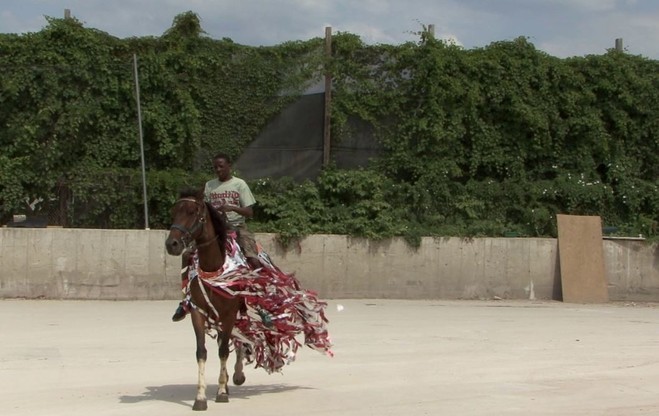Mohamed Bourouissa
Urban Riders
26 Jan - 22 Apr 2018

Mohamed Bourouissa, Horse Day, 2015
Diptyque vidéo (couleur, son), 13’39’’
Produit par Mobiles, Corinne Castel Avec le soutien du PMU
Courtesy de l’artiste et kamel mennour, Paris/London © Adagp, Paris, 2017
Diptyque vidéo (couleur, son), 13’39’’
Produit par Mobiles, Corinne Castel Avec le soutien du PMU
Courtesy de l’artiste et kamel mennour, Paris/London © Adagp, Paris, 2017
MOHAMED BOUROUISSA
Urban Riders
26 January – 22 April 2018
Curators : Odile Burluraux & Jessica Castex
The Musée d'Art moderne de la Ville de Paris is presenting Mohamed Bourouissa's first solo exhibition in a French museum. After catching the critics' eye at the emerging talent exhibitions Younger than Jesus at the New Museum in New York (2009) and Dynasty at the Palais de Tokyo and the Musée d’Art Moderne de la Ville de Paris (2010), this Franco-Algerian artist, born in Blida in 1978, is now one of the major figures of his generation.
In the early photographic series Périphérique (Peripheral; 2005–2008) and Temps mort (Down Time; 2008) the basic principles of his work were already evident: observation of society through its margins and collective activities that emphasise the human dimension.
The "Urban Riders" exhibition revolves around Bourouissa's film Horse Day, shot in the disadvantaged North Philadelphia neighbourhood of Strawberry Mansion. The film was a decisive stage in his artistic development.
During an eight-month residency he became interested in the Fletcher Street community stables, which he discovered thanks to the images of American photographer Martha Camarillo. Founded by African-American riders, the stables are a place of healing and imaginative crystallisation for local young adults and a refuge for abandoned horses. While not opting for a documentary approach, Bourouissa addresses the history of the stables, together with cowboy imagery and the conquest of wide open spaces.
As the months went by he worked at making contact and sharing with the local community. His cinematically meticulous film retraces this project, offering a powerful account of an urban utopia. Fascinated by the representation of America's black cowboys, Bourouissa tackles the recurring issues of territorial appropriation, power and transgression.
Horse Day comes with some eighty related items, graphic works conveying the artist's freedom of approach and the rich variety of his visual language. On-the-spot sketches, preliminary drawings, storyboard, collages, ink roughs and watercolours fill out the project's origins and development. There are, too, portraits of riders and of costumed horses whose "customising" metaphor is extended by images from the film printed onto sections of car bodies.
After being shown in different versions, notably at the Stedelijk Museum in Amsterdam and the Barnes Foundation in Philadelphia, the exhibition has been enlarged and revamped for the Musée d'Art Moderne. In addition a programme of workshops with guest artists will delve deeper into the questions of collective history and representation of identity.
With this project the museum renews its support for an artist whose photographic series Temps mort and film Legend are part of its permanent collection. To mark the exhibition an artist's book containing all Mohamed Bourouissa's works on paper will be published by Paris Musées.
Urban Riders
26 January – 22 April 2018
Curators : Odile Burluraux & Jessica Castex
The Musée d'Art moderne de la Ville de Paris is presenting Mohamed Bourouissa's first solo exhibition in a French museum. After catching the critics' eye at the emerging talent exhibitions Younger than Jesus at the New Museum in New York (2009) and Dynasty at the Palais de Tokyo and the Musée d’Art Moderne de la Ville de Paris (2010), this Franco-Algerian artist, born in Blida in 1978, is now one of the major figures of his generation.
In the early photographic series Périphérique (Peripheral; 2005–2008) and Temps mort (Down Time; 2008) the basic principles of his work were already evident: observation of society through its margins and collective activities that emphasise the human dimension.
The "Urban Riders" exhibition revolves around Bourouissa's film Horse Day, shot in the disadvantaged North Philadelphia neighbourhood of Strawberry Mansion. The film was a decisive stage in his artistic development.
During an eight-month residency he became interested in the Fletcher Street community stables, which he discovered thanks to the images of American photographer Martha Camarillo. Founded by African-American riders, the stables are a place of healing and imaginative crystallisation for local young adults and a refuge for abandoned horses. While not opting for a documentary approach, Bourouissa addresses the history of the stables, together with cowboy imagery and the conquest of wide open spaces.
As the months went by he worked at making contact and sharing with the local community. His cinematically meticulous film retraces this project, offering a powerful account of an urban utopia. Fascinated by the representation of America's black cowboys, Bourouissa tackles the recurring issues of territorial appropriation, power and transgression.
Horse Day comes with some eighty related items, graphic works conveying the artist's freedom of approach and the rich variety of his visual language. On-the-spot sketches, preliminary drawings, storyboard, collages, ink roughs and watercolours fill out the project's origins and development. There are, too, portraits of riders and of costumed horses whose "customising" metaphor is extended by images from the film printed onto sections of car bodies.
After being shown in different versions, notably at the Stedelijk Museum in Amsterdam and the Barnes Foundation in Philadelphia, the exhibition has been enlarged and revamped for the Musée d'Art Moderne. In addition a programme of workshops with guest artists will delve deeper into the questions of collective history and representation of identity.
With this project the museum renews its support for an artist whose photographic series Temps mort and film Legend are part of its permanent collection. To mark the exhibition an artist's book containing all Mohamed Bourouissa's works on paper will be published by Paris Musées.
